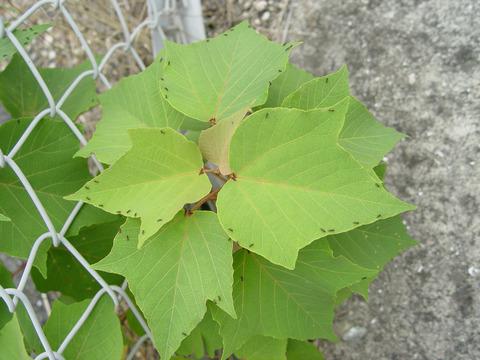当前位置:
X-MOL 学术
›
Funct. Ecol.
›
论文详情
Our official English website, www.x-mol.net, welcomes your feedback! (Note: you will need to create a separate account there.)
Species diversity and biological trait function: Effectiveness of ant–plant mutualism decreases as ant species diversity increases
Functional Ecology ( IF 5.2 ) Pub Date : 2021-06-12 , DOI: 10.1111/1365-2435.13859 Akira Yamawo 1 , Nobuhiko Suzuki 1 , Jun Tagawa 2
中文翻译:

物种多样性和生物性状功能:随着蚂蚁物种多样性的增加,蚂蚁-植物共生的有效性降低
更新日期:2021-06-12
Functional Ecology ( IF 5.2 ) Pub Date : 2021-06-12 , DOI: 10.1111/1365-2435.13859 Akira Yamawo 1 , Nobuhiko Suzuki 1 , Jun Tagawa 2
Affiliation

|
- One of the major concerns of ecological and evolutionary research is the prediction of community function in relation to the degree of biodiversity. To clarify the relationship between biodiversity and the expression of plant defence traits, we investigated ant–plant defensive mutualism in the pioneer plant Mallotus japonicus at several sites across Japan. The plant bears ant-attracting extrafloral nectar (EFN) and food bodies (FBs) as indirect defence traits.
- To reveal variations in ant–plant interactions in the field, we measured species richness of nectar-feeding ants and interaction strength between each ant species and the plant (visiting frequency of each ant species to the plant). We also investigated the expression of EFNs and FBs in natural plant populations at the study sites. To assess the defensive quality of each ant species, we then experimentally estimated the aggressiveness of the dominant ant species. To examine the link between ant species richness and the defensive function of ants, we conducted an ant-exclusion experiment and a common garden experiment to clarify whether the defence efficacy of ants varied in relation to ant species richness.
- Ant species richness differed among the study sites. We found negative relationships between ant species richness and the mean interaction strength of ant species, the interaction strength of aggressive ant species and the number of EFNs per leaf. The effectiveness of indirect defence by ants was poor at sites where ant species richness was high. When cultivated in the same environment, plants from sites with low ant species richness developed a larger number of EFNs per leaf than those from sites with high ant species richness.
- Our results suggest that facultative ant–plant defensive mutualism is weakened at sites where ant species richness is high, resulting in a decrease in the number of EFNs per leaf. Such a link between species richness and an indirect trait function may help us to understand the evolutionary patterns of various species traits in complex biological communities.
中文翻译:

物种多样性和生物性状功能:随着蚂蚁物种多样性的增加,蚂蚁-植物共生的有效性降低
- 生态和进化研究的主要关注点之一是预测与生物多样性程度相关的群落功能。为了阐明生物多样性与植物防御性状表达之间的关系,我们在日本多个地点调查了先锋植物Mallotus japonicus中的蚂蚁-植物防御共生。该植物具有吸引蚂蚁的花外花蜜 (EFN) 和食物体 (FBs) 作为间接防御特性。
- 为了揭示田间蚂蚁与植物相互作用的变化,我们测量了以花蜜为食的蚂蚁的物种丰富度以及每个蚂蚁物种与植物之间的相互作用强度(每个蚂蚁物种对植物的访问频率)。我们还研究了 EFNs 和 FBs 在研究地点的天然植物种群中的表达。为了评估每个蚂蚁物种的防御质量,我们然后通过实验估计了优势蚂蚁物种的侵略性。为了研究蚂蚁物种丰富度与蚂蚁防御功能之间的联系,我们进行了蚂蚁排斥实验和普通花园实验,以阐明蚂蚁的防御功效是否随蚂蚁物种丰富度而变化。
- 不同研究地点的蚂蚁物种丰富度不同。我们发现蚂蚁物种丰富度与蚂蚁物种的平均相互作用强度、攻击性蚂蚁物种的相互作用强度和每片叶子的 EFN 数量之间存在负相关关系。在蚂蚁物种丰富度高的地方,蚂蚁的间接防御效果较差。在相同环境下栽培时,与来自蚂蚁物种丰富度高的地点的植物相比,来自蚂蚁物种丰富度低的地点的植物每片叶子产生更多的 EFN。
- 我们的结果表明兼性蚂蚁 - 植物防御性共生在蚂蚁物种丰富度高的地方减弱,导致每片叶子的 EFN 数量减少。物种丰富度与间接性状函数之间的这种联系可能有助于我们了解复杂生物群落中各种物种性状的进化模式。



























 京公网安备 11010802027423号
京公网安备 11010802027423号